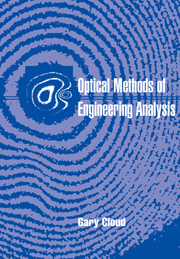
-
Select format
-
- Publisher:
- Cambridge University Press
- Publication date:
- 12 January 2010
- 26 May 1995
- ISBN:
- 9780511575013
- 9780521636421
- Dimensions:
- Weight & Pages:
- Dimensions:
- (253 x 177 mm)
- Weight & Pages:
- 1.069kg, 520 Pages
You may already have access via personal or institutional login
Book description
Fundamental measurement problems in engineering, mechanics, manufacturing, and physics are now being solved by powerful optical methods. This book presents a lucid, up-to-date discussion of these optical methods. Beginning from a firm base in modern optics, the book proceeds through relevant theory of interference and diffraction and integrates this theory with descriptions of laboratory techniques and apparatus. Among the techniques discussed are classical interferometry, photoelasticity, geometric moire, spatial filtering, moire interferometry, holography, holographic interferometry, laser speckle interferometry, and video-based speckle methods. By providing a firm base in the physical principles and at the same time allowing the reader to perform meaningful experiments related to the topic being studied, the book offers a unique user-oriented approach that will appeal to students, researchers and practising engineers.
Reviews
‘ … the book offers a unique user-oriented approach that will appeal to students, researchers, and practising engineers. It is written very clearly, contains a lot of practical examples, is well illustrated with diagrams and photographs, and each chapter is followed by references. The book is a classical one, but is a welcomed and needed addition to the literature.’
Source: International Journal for Light and Electron Optics
Contents
Metrics
Full text views
Full text views help Loading metrics...
Loading metrics...
* Views captured on Cambridge Core between #date#. This data will be updated every 24 hours.
Usage data cannot currently be displayed.
Accessibility standard: Unknown
Why this information is here
This section outlines the accessibility features of this content - including support for screen readers, full keyboard navigation and high-contrast display options. This may not be relevant for you.
Accessibility Information
Accessibility compliance for the PDF of this book is currently unknown and may be updated in the future.


